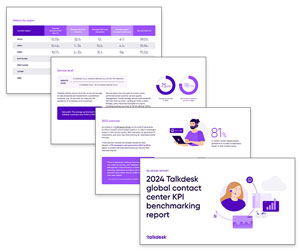Dave Salisbury argues that overuse of KPIs has become a disastrous issue in employee engagement.
It is most probable that you employ Key Performance Indicators (KPIs), such as Average Handle Time, After Call Work and Net Promoter Score, in your contact centre. But are you aware of the potential damage that they might be causing?
Below is a discussion of how KPI failure may well be setting your business back and 10 top tips for how your organisation can make better use of KPIs.
The Problem with Key Performance Indicators (KPIs)
KPIs continue to be a “buzz phrase” and a measuring tool, a flavour of the month managerial concern, and a disastrous issue in employee relations. Why is this a disastrous issue in employee relations?
KPIs have no meaning, no value, and are not grounded in reality. For all the resources invested, KPIs continue to reflect a bad investment at best. Yet, hope remains for KPIs if the paradigm is shifted and new thinking on an old topic is undertaken.
KPIs are intended to reflect what is needed for an employee to be adequately measured for performing the role of the position hired. This KPI definition is the simplest statement on this topic and forms the backbone of the discussion herein. Since KPIs are all about measurement, knowing what is being measured, why this particular aspect is being measured, and the specific actions required to improve must be clear, concise, and easily discussed.
When was the last time KPIs were reviewed for accuracy?
Please consider a common thought: when was the last time KPIs were reviewed for accuracy and the information being produced evaluated for veracity and actionable application? If the answer is “I don’t know” or longer than 24 months previous, this is the first problem.
KPIs should be producing actionable data. For example, Net Promoter Score (NPS) is a KPI in which a baseline is established.
- What is the baseline?
- What are the parameters for high/low?
- What specific actions can an employee take to improve NPS to meet the parameters?
- Does the KPI standard make sense to the new employee?
- Can a seasoned employee easily explain improvement to a new employee?
- If the KPI is not directly tied to actions, why is this a measurable KPI? (Actionable data is crucial in KPI discussion.)
Active Issues (AI)
Here is another point regarding actionable data in measuring KPIs. Active Issues (AI) is a general KPI in many service-related call centres. Can an employee receive a zero (0) as a measurement?
The most frustrating conversation I ever had on a project was being charged an AI because the measurement system could not accept a zero in this category, even though the company preached zero-AI to all employees. Obtaining the desired KPI meant the employees had to be charged an issue and, in being charged the issue, were then held accountable for not reaching the desired AI goal of zero. Actionable data must be able to accept the performance desired and achieved to meet the employee performance.
KPI veracity is found in the usefulness of the data to the individual employee and direct supervisor. KPI actionable application is found in being able to identify specific actions the employee can take to improve performance on a single indicator. This actionable application hinges upon the need to understand what is being measured and being able to explain why it is being measured, along with the value of that measurement to the overall organisation.
Average Handle Time (AHT)
For example, Average Handle Time (AHT) is a common call centre KPI measurement. Is AHT being measured because you do not want employees on the phone too long? Or what about too short a handle time? What value is AHT measuring and how does AHT benefit the company overall? Can the direct supervisor specifically speak to actions the employee is making to improve performance? All of these questions must be addressed to empower the employee in how to improve based upon KPI measurement.
What do the numbers mean?
During my first performance interview in a call centre, I asked about KPIs, specific actions to take, what the numbers meant and what did improvement look like for each of the 40 KPIs being discussed. The answer from my frontline supervisor on the majority of the KPIs was “I don’t know.” More egregious was the insistence that “it works” and not to “rock the boat”. The supervisor refused to find out what the KPIs meant because the supervisor had no idea where the measurements came from, and who was responsible for the KPIs, and did not want to “rock the boat”.
Another issue regarding actionable application and veracity is the power of surpassing expectations. Should an employee surpass the expectation, is the employee harmed because of being better than the KPI dictates? An example of this is found in another common call centre KPI, After Call Work (ACW). If the standard for ACW is 10 seconds and the diligent employee drives their ACW to zero (0), as per the published company desired goals, can the KPI measurement accurately reflect the employee’s performance? If not, the KPI process is having significant issues in delivering actionable and truthful data to organisational leaders.
KPI failure

Here is another real-world example on KPI failure. While working a project in a call centre, I discovered how to obtain KPI excellence in ACW and taught managers and other employees how to obtain KPI excellence in ACW. At the end-of-the-month meeting for KPI adherence, I won an award for obtaining 0 ACW, but the bonus cheque was based upon 1-second ACW because the KPI measurement system could not accept a 0. More to the point, I also received a counselling statement for having time in ACW. The award and counselling statement were delivered the same day, and the manager did not see the irony or problem with the KPI issue. The insult to injury came when pointing out this error and being told by the VP of Customer Service that the business will not change to accommodate.
When working with KPIs, the data must be able to be tied to specific actions of those being measured. The actions are being measured and weighed, and the actions need to make sense by providing logic to the employee. The KPI might make sense to an organisational leader or a high-level manager, but if the employee being measured cannot logically understand the KPI, the measurement cannot accurately reflect actionable data.
Voice-of the-Customer (VoC) scores
For example, “Voice-of the-Customer” (VoC) remains a favourite call centre KPI, but many times, the VoC score does not make sense as the actions the employee is told to take often do not impact an VoC because the customer survey is all about the perception of the customer, not the work of the employee. If the customer does not like the data presented and fills out the VoC survey with malice and vindication, how is the customer agent expected to make improvement in VoC? The customer service representative cannot influence the customer after the call and before the survey is completed; the customer is making choices; providing the best service is irrelevant and the employee is punished for a low VoC. If the agent delivering the service does not control the actions, the KPI is both inaccurate and ineffective!
KPI baselines
ACW and AHT bring up an excellent auxiliary topic, baselines. Baselines are averages and beg the question as to when and who established the basic data being averaged to measure performance. How were the baselines established originally? Have the baselines been reviewed for application in the current business environment? Do the baselines still make sense? More specifically, if the baselines and averages do not reflect current reality, why are they still a KPI? If training to meet the KPI is insufficient, how can an employee meet the rigours the KPI demands?
Why should the baselines change?
On a call centre project, I asked when the AHT/NPS/ACW/VoC and other KPIs were established. The frontline supervisor was part of the project in their first year of employment to establish KPI baselines. The supervisor was a 15-year veteran of the company and I asked when the baselines would be reviewed due to new technology, new processes, new procedures, and business changes since inception of the original baselines. The response remains classic, “Why should the baselines change? This is why they are called baselines.” Baselines should change as the KPIs are reviewed. When products and services change, the baselines need to be reviewed to ensure veracity and applicability. More specifically, actionable data takes a downturn when baselines are insufficient to proper measurement of performance.
How to make better use of KPI
1. Plan to review the KPI as a process at a minimum of every 18 months
Plan to review the KPI as a process at a minimum of every 18 months, and sooner if products and services change. Review sooner if technology shifts and every time a trigger in the company processes occurs, e.g., back-office changes, legislation, etc. Regardless, set in place plans to maintain KPI shelf life and allow the KPI process to live, change, and become a tool to improve people.
2. Make a single person responsible for each KPI being measured
For example, if there are 15 KPIs in an employee’s performance review, then 15 different people should have a collateral duty to be responsible for the life of that KPI. These people should be approachable, knowledgeable, and have an in-depth knowledge of the job being done to adequately measure the performance of others and how this influences the company’s goals and objectives overall. More specifically, if those in charge have not performed the job, why are they in charge of the KPI to measure the job?
I worked on a project where the senior leaders, team leaders, directors, etc., were required to spend 8 hours a month on the phone as a frontline customer-facing representative in an effort to keep the leaders knowledgeable of the frontline tasks, current customer environment, and to gauge process and procedure application in a real world. The customers and the customer-facing employees appreciated seeing this, and it made the leaders more cognisant of what is happening in the business from a frontline perspective.
3. Never allow the KPI to be a punishment tool

Training, yes; development, absolutely; punishment, never. Should actions have consequences, yes; but these consequences must be separated from the KPI measuring system. Triggers for frontline supervisors from the KPIs need to be removed and placed into the hands of human resource managers and non-frontline superiors/directors. This allows for the relationship of training to remain with the frontline supervisor and places control of KPI consequences at a level where the employee can receive neutral assessment of performance.
4. Never allow a KPI to be measured if the employee does not have 100% control over how to improve that KPI
While NPS is a fine item to measure, do not allow NPS to be a performance item, use this as a bonus item at best or a team item for judging team performance, but individuals must have 100% control over their own performance for a KPI to be actionable.
5. Simplify KPIs
Remember the elevator speech. Can the KPI measurement be discussed in an elevator speech? If not, the KPIs need to be simplified, honed, and focused. Imperative to effective KPIs remains actions the individual can control.
6. Drop the canned phrases, key words, and other “flavour-of-the-month” managerial gimmick
KPIs should never be based upon word adaptation. Every person does not successfully use terms someone else uses to succeed. Personalisation helps the customer feel their problem is original. Canned responses rob the customer of this feeling and the customer feels “shoe-horned” into the one-size-fits-all answer.
7. Remember employee individuality
Remember the individuality of the employee when choosing which KPI is to be measured and how that measurement is created. For example, once a baseline is established, does the employee retain freedom to control their own destiny in meeting the KPI or is the employee “shoe-horned” into one-size fits most measurement device?
8. Action plans need KPIs; KPIs need action plans
As a measurement tool, gauging actions and placing a statistical variable onto that tangible, a non-static atmosphere enveloping the KPI conversation is needed. If the plan needs measuring, there must be a KPI. If the KPI is to achieve the most use, an implemented action plan to be measured must exist.
9. Don’t settle for what every other business measures in the industry
If AHT does not fit your call centre, remove it. If a manufacturing employee cannot control cycle time, do not use it to gauge employee performance. KPIs should be a hybrid solution to measuring employee actions and not represent KPI measuring to an entire industry. Allow the KPI measuring system to be individual, explainable, and conducive to all employees being able to detail the “why” and the “what” in measurement.

Dave Salisbury
10. Do not forget to include the “how”
How does an employee improve? How do the numbers directly represent actions? How easy is the KPI measurement system explained to another person? Once the “why” and the “what” are known, the “how” should be a simple extension of the logic in the KPI process.
With thanks to Dave Salisbury, Operations and Customer Relations Specialist
For more great insights from David Salisbury, view our articles:
- What Is the Purpose and Mission of Your Contact Centre?
- What “Going the Extra Mile” REALLY Means in Customer Service
- How to Be a Leader in the Contact Centre
Author: Dave Salisbury
Reviewed by: Jonty Pearce
Published On: 21st Dec 2016 - Last modified: 16th May 2024
Read more about - Call Centre Management, Average Handling Time (AHT), Dave Salisbury, Employee Engagement, Key Performance Indicators (KPIs), Measurement, Metrics, NetPromoter Score (NPS), Voice of the Customer






































